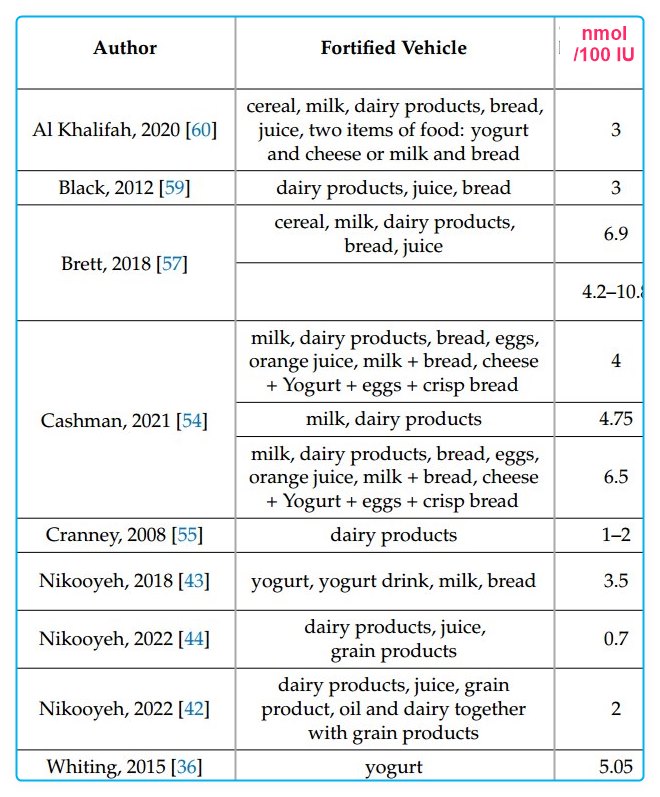Response to Vitamin D fortification varies from 1 to 10 nmol per 100 IU daily – review
Fortification of Staple Foods for Household Use with Vitamin D: An Overview of Systematic Reviews
Nutrients 2023, 15(17), 3742; https://doi.org/10.3390/nu15173742
by Patrick Nyamemba Nyakundi 1,2,†ORCID ,Zsuzsanna Némethné Kontár 1,†,Attila Kovács 3,Luca Járomi 1ORCID, Afshin Z and 1 and Szimonetta Lohner 1,3,*ORCID
1 Department of Public Health Medicine, Medical School, University of Pécs, 7624 Pécs, Hungary
2 Doctoral School of Health Sciences, Faculty of Health Sciences, University of Pécs, 7621 Pécs, Hungary
3 Cochrane Hungary, Clinical Center of the University of Pécs, Medical School, University of Pécs, 7623 Pécs, Hungary
Author to whom correspondence should be addressed.
PDF table of contents


Vitamin D deficiency is a global public health concern with significant implications for bone health and chronic disease prevention. Our aim was to summarize the evidence from Cochrane and other systematic reviews evaluating the benefits or harms of vitamin D fortification of staple foods for household use. In April 2023, we systematically searched Ovid MEDLINE, Embase, Epistemonikos and the Cochrane Database of Systematic Reviews for systematic reviews investigating the effects of vitamin D fortification of food in general populations of any age. We used Cochrane methodology and assessed the methodological quality of included studies using AMSTAR (A MeaSurement Tool to Assess Systematic Reviews). We assessed the degree of overlap among reviews. All outcomes included in systematic reviews were assessed. The protocol is registered in PROSPERO (registration number: CRD42023420991). We included 27 systematic reviews out of 5028 records for analysis. Overall, 11 out of 12 systematic reviews calculating pooled estimates reported a significant increase in serum 25(OH)D concentrations. The mean change in serum 25(OH)D concentrations per additional 100 units of vitamin D ranged from 0.7 to 10.8 nmol/L. Fortification of food with vitamin D showed a reduction in the prevalence of vitamin D deficiency based on high-certainty evidence. Parathormone (PTH) levels were described to decrease, bone mineral density to increase, while the effects on other bone turnover markers were inconsistent. Fortification did not significantly impact most anthropometric parameters, but it seemed to positively influence lipid profiles. In summary, fortification of food with vitamin D results in a reduction of vitamin D deficiency and might increase serum 25(OH)D concentrations, to varying extents depending on the fortified vehicle and population characteristics. Additionally, fortification may have a positive impact on bone turnover and lipid metabolism but may only have a limited effect on anthropometric parameters.
📄 Download the PDF from VitaminDWiki
VitaminDWiki – Fortification with Vitamin D contains
{include}
VitaminDWiki – Bread Fortification contains
{include}
VitaminDWiki – Change of Vitamin D Fortification in Denmark contains
{include}
Many reasons for a poor response to Vitamin D fortification
Genes
Low fat content of food ( if the vitamin D is fat, rather than water soluable)
Note: 2.5% and 0% fat fortified milk provides far less response than 4% milk
Time of day (near supper is best, breakfast is worst)
Have a current health problem that is consuming Vitamin D (surgery, diabetes, some cancers)
Have a current health problem that is associated with poor response (Asthma, COPD, MS, Obesity...)
Poor level of some B vitamins
-
- 39% increase in vitamin D levels: low Boron diet to Boron replete diet. 3 mg of Boron/day for 49 days
Poor gut, fatty liver
People who are extremely deficient will have virtually no response until their levels start to be respored
Elderly have about 1/4 the absorption of Vitamin D from their intestines
-
See also: low response to fortification, oral, UV, etc
Vitamin D Nutrigenomics - High, Medium, and Low Responders - March 2019
Boron improves magnesium absorption and may help vitamin D non-responders – Aug 2015
